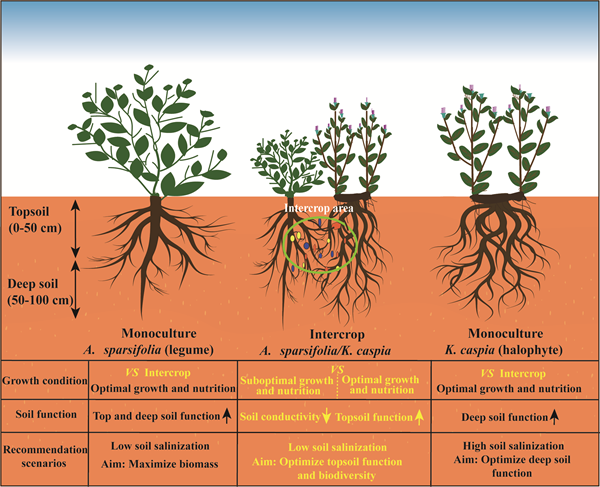Researchers Reveal that Monoculture can Provide Higher Ecological Functions than Intercropping in a Desert Ecosystem
2024-04-16
Desert ecosystem restoration presents a particular challenge due to these ecosystems' inherent fragility and harsh environmental conditions. One approach for active restoration involves planting native species, which can accelerate the recovery of ecosystem functions.
In a study published in the Journal of Environmental Management, researchers led by Prof. ZENG Fanjiang from the Xinjiang Institute of Ecology and Geography (XIEG) of the Chinese Academy of Sciences have experimented with an active restoration approach of intercropping native desert plant species to evaluate its impact on soil nutritional status and ecological functions.
Researchers planted a phreatophytic legume (Alhagi sparsifolia) and a halophytic non-legume (Karelinia caspia) in the Taklamakan Desert, China. Following a block design experiment, these species were grown in both monoculture and intercrop communities for four years.
Researchers revealed that single-legume cultivation resulted in the highest biomass production. They found that halophyte monoculture improved ecological functions related to nitrogen concentration in the topsoil, while phosphorus, carbon, and sulfur concentrations in the deep soil. Halophyte monoculture also elevated sodium ion concentration in the plant biomass.
In addition, intercropping enhanced nutrient concentration and enzyme activities in the topsoil but also led to an increase in soil sodium ions concentration and pH.
Researchers suggested that if the primary goal is to optimize biomass accumulation, legume monoculture is recommended. On the other hand, halophyte monoculture is advisable if the objective is to extract sodium from the soil or enhance ecosystem functions in the deep soil. If there is no risk of salinization, intercropping the two species is recommended to maximize the ecosystem functions of the upper soil.
"When implementing an active restoration program, it is vital to select the appropriate plant species and planting patterns, considering the chemical condition of degraded soil and the specific ecosystem functions that need to be prioritized,” said Dr. Akash Tariq, first author of the study.
The study presents an important reference for ecological restoration programs, highlighting the need for more work to optimize solutions for different arid ecosystems.
Article link:https://doi.org/10.1016/j.jenvman.2024.120807

Figure 1: Recommended scenarios of plant growth, soil function and planting patterns under the monoculture of Alhagi sparsifolia and Karelinia caspia, and their intercropping. (Image by XIEG)
Contact
LONG Huaping
Xinjiang Institute of Ecology and Geography
E-mail: longhp@ms.xjb.ac.cn
Web: http://english.egi.cas.cn



